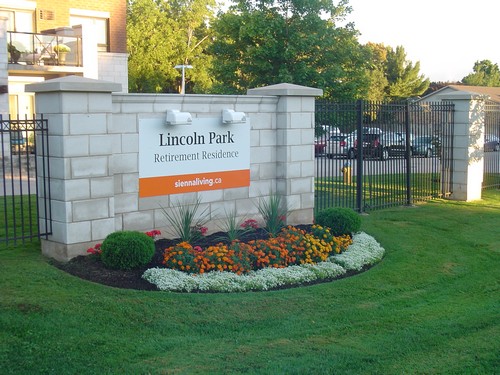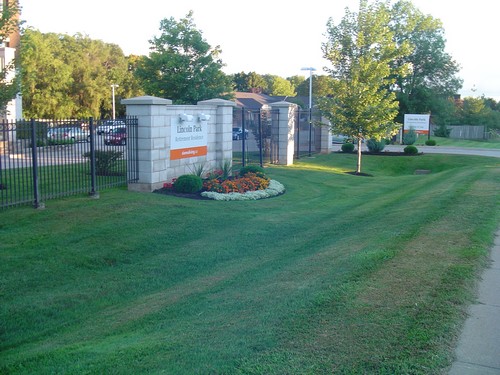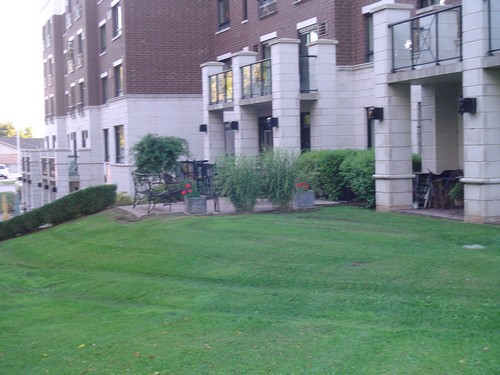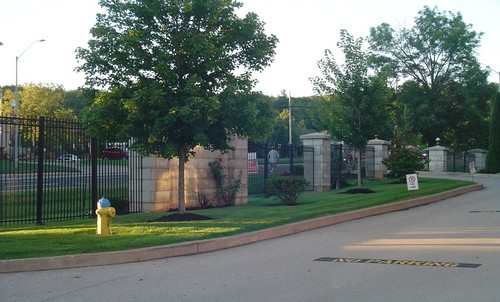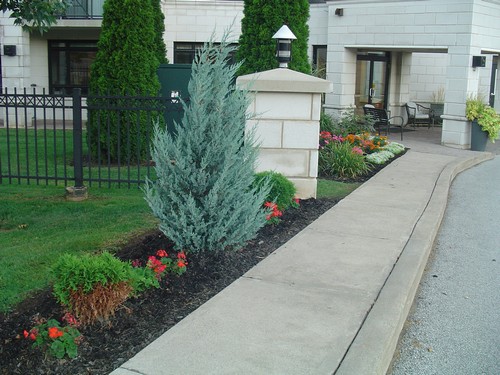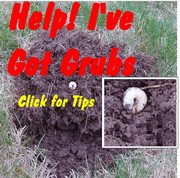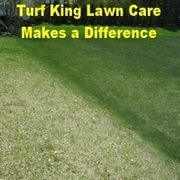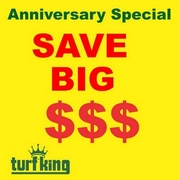Crabgrass Problems
Crabgrass is usually found along the edges of the lawns. Most lawn edges abut some sort of hard surface- concrete, interlock, asphalt.
It is important to recognize now crabgrass grows and functions. It is an annual weed- it will die in the fall with a heavy frost. However, the seeds are scattered in the lawn and will grow next year. Removing the current crop of crabgrass plants will reduce the supply of crabgrass seeds that will be in the soil. This is labour intensive and may not be worthwhile.
The seeds germinate next year when soil temperatures are warm enough for them.
This means that crabgrass does not germinate until late June in most cases.
Crabgrass need warm soil to germinate. So it tends to grow where the soil is warmer. Places where the soil may be warmer include lawn areas that are not thick. A thin lawn may have areas of bare soil. Bare soil warms up easier than soil that is protected by a thick stand of lawn.
Crabgrass rarely grows in shady lawns for this reason. Crabgrass growing in the middle of a lawn is most often in lawns that have suffered insect damage the previous year. This causes the lawn to be thinner than normal and allows crabgrass to germinate and grow.
Lawns along the edges of hard surfaces will warm up more than other lawns. The asphalt and concrete absorbs the sunlight and gets warm. This warmth is transferred to the lawns along the edges and provides conditions that crabgrass will thrive in.
We do recommend that lawns be mowed at a height of at least 3 inches. This allows for a denser canopy of grass blades. The longer blades provide more shade on the ground than shorter blades. The more shade, the cooler the soil will be – and crabgrass will be less likely to grow.
The way the edges are trimmed can also be a factor in how well crabgrass grows. Edges along paved areas should NOT be trimmed lower with a string trimmer. This trimming will shorten the mowing height along the edge and reduce shade and increase soil temperatures. This can lead to an increased risk of crabgrass infestation.
Another factor that relates to mowing height is when the lawn is slightly raised above the pavement or walk. If the lawn for instance is 1 inch higher than the pavement – when the mower is run along the edge of the lawn, the lawn along the edge will be mown at a height lower than the 3” mowing height of the lawn that is farther away from the edge.
Lowering the lawns along the pavement edges, can help to ensure that lawn edges are not inadvertently mowed lower than is desirable. Doing this work should only have to be done once but will likely pay dividends in reducing crabgrass over the long run.
If the lawn along a pavement edge is not as dense as it can be, if it is thin or bare, then it is doubly susceptible to crabgrass infestation.
There are a number of things that can make lawn edges bare. These include
-being driven on by vehicular traffic
-burn or scorching from trash bags and recycling boxes
-salt damage from winter ice melting
-damage from snow clearing
To reduce bare areas- first reduce the cause that may cause damage and second repair the damage to increase lawn density and reduce crabgrass germination.
If salt is used regularly on the driveway or walkway- treatments can be used to reduce damage from salt. A granular applications of Turf King LOGI-CAL will help salt accumulations wash down the soil profile to below the root zone of the lawn. This can be applied in the spring after damage is noticed or applied as a preventative measure in the late fall.
WE received an Email From Lincoln Park Retirement Residence in Grimsby
In 2014, we set a 2 year goal to have out property looking as nice as Evergreen Terrace across the road in the first photo.We were like the envious neighbor in the Scott's fertilizer commercial.
In saying that, we put the challenge out to Mike Swaerdens of Hysert Greens Landscaping & to Gerry & Mark of Turf King Lawn Care to have our property looking as good as Evergreen Terrace.
Not only did they meet it, we are looking better than Evergreen Terrace across the road, and had many compliments from residents and family. We had a resident's family stay here from England this summer and they were very impressed with our landscaping and green, well manicured lawns.
Thanks for your hard work in achieving this goal and look forward to you serving us in the future.
Paul Juhlke
EVS Manager
Lincoln Park 265 Main St. East, Grimsby ON
Sienna Senior Living
The warmth of human connection
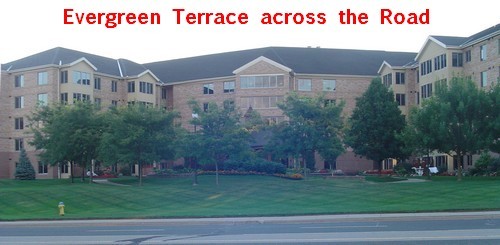
A Brief Guide to Maintaining Your Lawn Healthy During a Dry Spell
In this area, Environment Canada says that in this part of Ontario we have received only half of the usual rainfall in the past 8 weeks.
While we haven't received any watering restrictions, they might be next.
How will you ensure that your lawn is healthy during the dry season?
Mowing
- Mow your lawn 3-4 inches high. This will leave grass that will ensure deeper root development. It will also provide shade to the soil, therefore reducing the rate of evaporation of water from the ground.
- Maintain the cutting edges of the blades sharp. Blunt blades on the mower shred grass tips, which makes the lawn turn brown.
- You may leave grass clippings on the lawn after cutting to act as mulch.
- Mulching gives the roots more shade, which means less dissipation. It also helps the lawn retain water.
- Trim the grass growing close to the sprinkler heads to make sure that the sprinkler nozzle is not blocked.
Watering
- Reduce your watering plan. this wil enable you to maximise on the availablle water to maintain tha grass during the dry season.
- Sections of the lawn that are under shade (north/east side of the house) will require 50 percent less water as compared to those on the sunny side of the house. Modify your watering plan meets the watering needs of these sections.
- Water very early in the morning from 3 AM to 8 AM. Temperatures are cool; the wind is quiet, and there is little evaporation.
- To reduce the amount of spill over and water waste, utilize the cycle and drench technique for watering. Space every watering cycle around an hour separated to allow absorption y the soil.
- Make sure that the sprinklers do not water the pavement through adjusting them to ensure that water reaches to the edge of the lawn.
- When watering the grass, it is best to mimic nature and sprinkle profoundly without sustained frequency to re-enact normal precipitation.
- This will encourage deep root development since they will grow deeper in search of water. Lightly watered turf does not encourage root development for plants that need water frequently hence making them unable to survive a drought.
- If your lawn starts turning to dark-blue or the grass cutting edges don't spring back after you walk on it, don’t worry. It's just a way of telling you that it needs some water to keep it going through this dry season.
- In an extended dry season, where no supplemental water is accessible, most grasses turn brown and become dormant in a final desperate attempt to remain alive. Dormant grass is not dead, and it will grow again once it rains.
Traffic
- Excess traffic by human beings and animals easily damages grass that has been stressed by drought.
- Try not to do anything that will add stress to the plant, including vigorous yard exercises and pedestrian activity. If it is unavoidable, keep it to a minimum.
Cultural Practices
- A lawn experiencing drought is usually under stress. This is one of those times when it's best to simply not do anything to your lawn.
- Try not to de-thatch or topdress the lawn.
Conclusion
Accept the fact that your lawn may not be that lush during the dry season. It will ensure that you will adapt psychologically to seeing changes happening to your lawn and be patient enough until the dry season ends.
by: papawemba

